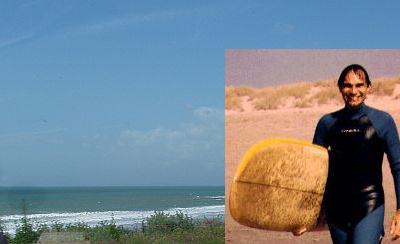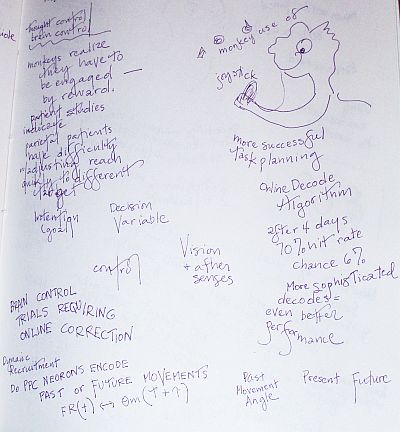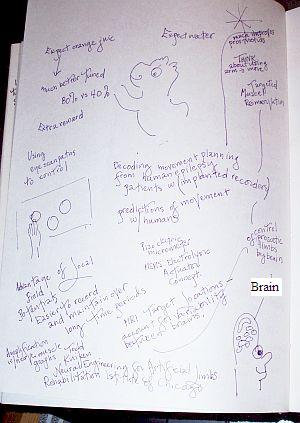Swartz-Sloan Centers for Theoretical Neurobiology:
Annual Summer Meeting
Caltech, July 23-26, 2005
Richard Andersen, Caltech, invited speaker
Decoding cognitive variables with brain-machine interfaces

Below are interesting and exciting notes from Andersen Lab Research Page
See also "Outsider" Lecture Notes below
A neural prosthesis using the posterior parietal cortex.
Our lab is currently testing the possibility of developing a neural prosthesis for paralyzed patients based on some of our new findings, described BELOW. We have found that early plans for movements are made in the posterior parietal cortex. Since these ideas for movement are highly cognitive, indicating a spot in the visual world where the animal wishes to reach, we will examine whether there is sufficient information in a small number of neurons to control a reach movement. We have implanted arrays of electrodes in MIP in monkeys to record from small populations of neurons to read out the animals' reach plans. It is difficult to record for long periods of time from single neurons, so to aid in our stability of recording we have drawn on another of our recent findings. The local field potential is tuned similarly to the single cells, and is much easier to record over long periods. This finding may represent a leap forward in improving multi-site recordings. We have recently trained monkeys to move a cursor on a computer screen just by thinking about it; i.e., by collecting and analyzing the intended reach signals from an ensemble of neurons and "reading out" in which directions the animal intends to reach. Although the task is very rudimentary, this result indicates that, in principle, signals from small populations of cells in the posterior parietal cortex could be used to record from the cortex of patients with paralysis either to operate prosthetic limbs or to communicate through a computer. Practical experiments such as the prosthesis project have the advantage of requiring us to test directly our ideas regarding the functions of the posterior parietal cortex. In the future we plan to maintain both basic research and applied research directions, with the hope of translating basic research findings into useful clinical applications.
Intentions. Research from our lab has provided evidence that the posterior parietal cortex represents a stage where the early plans to make movements are formulated. Moreover, there appears to be a map of intentions within the region. Many years ago we discovered a cortical subdivision of the posterior parietal cortex, area LIP (for lateral intraparietal area) that is specialized for planning rapid (saccadic) eye movements. More recently we have found a parietal reach region (which includes the medial intraparietal area, MIP), which is specialized for planning reaching movements. As indicated above, both areas plan movements in eye coordinates, with this activity gain modulated by other body part position signals. Another parietal area, AIP, has been discovered by Sakata and his colleagues which appears to be specialized for grasp. We are currently examining area 5, a classic high order somatosensory area, and finding that this area also has reach-related planning activity in eye coordinates.
Motion perception.
While some areas of the parietal cortex are involved in action planning, others are involved in processing higher order aspects of motion perception. To obtain a deeper understanding of the organization of the posterior parietal cortex we have also studied these motion areas. One line of experiments in our lab has examined how we perceive the shape of objects from motion cues, so-called structure-from-motion. Monkeys are trained to perform tasks in which they indicate their immediate perceptions when viewing bistable motion displays that can be perceived in either of two ways. These displays have the advantage of producing two entirely different percepts, at different times, from the same physical stimulus. We find that although only a small percentage of cells in primary visual cortex are modulated by perception, a much larger percentage (approximately half) of the cells at the subsequent stage (in the middle temporal area/V5) differentiate between the two percepts. Moreover, our experiments suggest that this illusion taps into a basic mechanism for surface segmentation based on motion cues and depth (disparity) cues.Temporal structure in memory activity.
Early movement plans in the posterior parietal cortex can exist in the absence of sensory stimuli or movement. This persistent neural activity is a form of short term, "working" memory, but for a movement plan. If, as many believe, this memory is produced by reverberating circuits, then there should be temporal structure in the activity. Until recently it has not been possible to demonstrate oscillations in cell activity under these conditions. However, using a sophisticated signal processing technique, multi-taper spectral analysis, we have been able to demonstrate temporal oscillations in both the spike activity and the local field potential in this planning activity. The spikes and local field are coherent at zero phase, suggesting that the local field represents the synchronized firing of many cells. The high frequency (gamma) band of local field activity is spatially tuned, whereas a lower (theta) band varies with the expectancy of the animal and decreases dramatically at the time of movement execution."Outsider Notes"
Go to Richard Andersen Lab Web Page



Go back to the Outsider Page